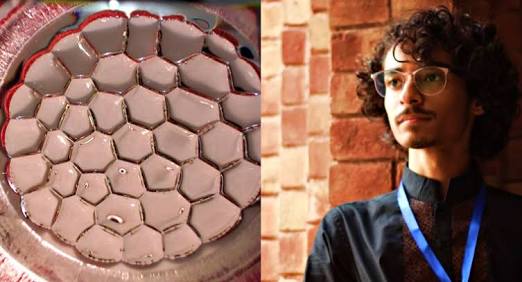Shaheer Niazi’s Electric Honeycomb Research is making us Pakistan proud
Calling him Pakistani Newton or naming him for some other scientist would be unfair because Muhammad Shaheer is on the way to make his own recognition in the world of science.
Yes, he, the 17 years old researcher from Pakistan who loved watching documentaries on science in the age when kids usually love listening fairy tales have brought Pakistan to the map of Science.
The boy interested in mathematics and other science subjects since his childhood has got published his Electric Honeycomb Research in Royal Society Open Science journal.
He received an official acceptance letter when he was only 16.
The genius has completed his latest research on the visual presentation of “electric honeycomb”, providing the internet with a new topic to talk about.
Though the Physicists are already familiar with the phenomenon of electric honeycomb, the special from this O-Level student, LCAS from Lahore is the filmed view of migration of ions from the honeycomb.
He recalls that how while preparing for the tournament at the labs at the Lahore University of Management Sciences (LUMS), Dr Sabieh Anwar, the lead in the PhysLab initiative, handed him a thermographic camera and he began taking his own pictures.
He also caught on camera temperature differences on the surface of a layer of oil in an electric field between a pointed electrode and a flat one. And he did the shadowgraphy that has never been done before.
Thus his shadowgraphy to image the ion stream made him the permanent figure of the science space.
Aiming at another Nobel to bring in Pakistan while talking about his inspiration disclosed that it came from Dr. Izquierdo’s 1997 work. Who, being a self-taught pianist and interested in music and Arts, creates excellent pencil sketches.
He credited his mother for getting published and said that her encouragement after returning from International Young Physicists’ Tournament made him get published.
The teams from over 30 countries around the globe were present to join the 29th IYPT in 2016, where Niazi succeeded and got published.
He says also talked about the two new factors in the electric honeycomb phenomenon that are intended to remove the bugs from his existing knowledge and were mandatory to get published.
The inspiration also talked about the online and self-learning process that played an essential role in multiplying his knowledge and attracting media unexpectedly.
He has also taken almost 25 courses from venture-backed, education-focused technology company – Coursera.
The team representing Pakistan at the International Young Physicists’ Tournament was being led by Shaheer’s twin sister, Khadija Niazi, who decided to write a paper on his findings.
Professor Troy Shinbrot at the Rutgers University who helped the twins in getting their written work polished is glad to see the work published.




